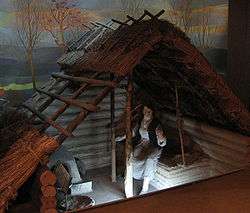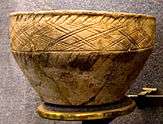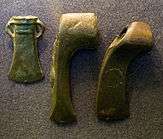Srubna culture

| Part of a series on |
 |
|
|
Origins |
|
Archaeology Pontic Steppe East-Asia Eastern Europe Northern Europe Pontic Steppe Northern/Eastern Steppe Europe
South-Asia Steppe Europe Caucasus India |
|
Peoples and societies Indo-Aryans Iranians Europe East-Asia Europe Indo-Aryan Iranian |
|
|
The Srubna culture (Russian: Сру́бная культу́ра, Ukrainian: Зрубна́ культу́ра), English: Timber-grave culture, was a Late Bronze Age (18th–12th centuries BC) culture.[1] It is a successor to the Late Catacomb culture and the Poltavka culture,[1] as well as the Potapovka culture.
It occupied the area along and above the north shore of the Black Sea from the Dnieper eastwards along the northern base of the Caucasus to the area abutting the north shore of the Caspian Sea, west of the Ural Mountains to come up against the domain of the approximately contemporaneous and somewhat related Andronovo culture.
The name comes from Russian cруб (srub), "timber framework", from the way graves were constructed. Animal parts were buried with the body.
The economy was mixed agriculture and livestock breeding. The historical Cimmerians have been suggested as descended from this culture.
A study on DNA variation among ancient Europeans found that, of the 6 samples extracted from Srubna culture sites for whom a Y-DNA hapogroup could be tested, all belonged to haplogroup R1a, and four of them to subclade R1a-Z93, which is common among modern-day Indo-Iranians.[2]
The Srubna culture is succeeded by Scythians and Sarmatians in the 1st millennium BC, and by Khazars and Kipchaks in the first millennium AD.[1]
 |
 |
 |
Genetics
In a study published on 10 October 2015,[3] 14 individuals of the Srubna culture could be surveyed. Extractions from 100% of the males (six men from 5 different cemeteries) were determined to be of Y-chromosome haplogroup R1a1. Extractions of mtDNA from fourteen individuals were determined to represent five samples of haplogroup H, four samples of haplogroup U5, two samples of T1, one sample of T2, one sample of K1b, one of J2b and one of I1a. The list of 14 surveyed individuals:
- Kurgan burials at Spiridonovka IV cemetery:
- kurgan 1, grave 11, sample I0360, male - Y-DNA R1a1 (SRY1532.2) and mtDNA U5a1
- kurgan 2, grave 5, sample I0361, male - Y-DNA R1a1a (M17) and mtDNA H5b
- kurgan 1, grave 6, sample I0359, female - mtDNA U5a2a1
- kurgan 1, grave 15, sample I0354, female - mtDNA U5a1
- kurgan 2, grave 1, sample I0358, female - mtDNA H6a1a
- Kurgan burials at Spiridonovka II cemetery:
- kurgan 1, grave 1, sample I0430, male - Y-DNA R1a1a1b2a2a (Z2123) and mtDNA H3g
- kurgan 1, grave 2, sample I0431, female - mtDNA H2b
- kurgan 11, grave 12, sample I0421, female - mtDNA H3g
- Kurgan burials at Barinovka I cemetery:
- kurgan 2, grave 17, sample I0423, male - R1a1a1b2 (Z93) and mtDNA J2b1a2a
- kurgan 2, grave 24, sample I0422, female - mtDNA type T1a1
- Kurgan burials at Novosel’ki cemetery:
- kurgan 6, grave 4, sample I0232, male - R1a1a1b2 (Z93), mtDNA U5a1f2
- Kurgan burials at Uvarovka I cemetery:
- kurgan 2, grave 1, sample I0424, male - R1a1a1b2 (Z93); mtDNA T2b4
- Kurgan burials at Rozhdestvenno I cemetery:
- kurgan 5 grave 7, sample I0234, female - mtDNA K1b2a
- kurgan 4 grave 4, skeleton 2, sample I0235, female - mtDNA I1a1
References
- 1 2 3 J. P. Mallory, "Srubna Culture", Encyclopedia of Indo-European Culture, Fitzroy Dearborn, 1997.
- ↑ Iain Mathieson; et al. (2015). "Eight thousand years of natural selection in Europe". doi:10.1101/016477.
- ↑ Mathieson, Lazaridis et al. (2015). "Eight thousand years of natural selection in Europe". bioRxiv: Supplementary Information. Archaeological context for 83 newly reported ancient samples. Pages 12–14. doi:10.1101/016477.
External links
-
 Media related to Srubna culture at Wikimedia Commons
Media related to Srubna culture at Wikimedia Commons